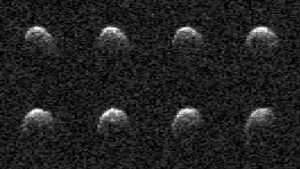
One of the most under-appreciated tools in planetary science is the ground-based radar dish. At a certain level, any radio dish can be turned into a radar dish if you just give it a powerful enough signal. At the most simplistic level, radars send out signals in a known direction and at a known time, and by listening to hear when those signals reflect back, it’s possible to map out the shape or shapes of objects. Essentially, if it takes longer for stuff to reflect back, they are farther away, if it takes less time, they are closer, and if there is no reflection, there is nothing capable of reflecting light straight back out there.
Stealth tech defeats radars by reflecting signals in all sorts of crazy directions, and minimizing how reflective their surfaces happen to be.
Asteroids are really good at reflecting radar signals, and for decades, researchers on Earth have trained massive dishes at these passing rocks and used radar to map their shapes. In fact, we can even measure how quickly they’re rotating and get their entire three-dimensional structure if we can watch them for a long enough period of time
And this is exactly what JPL’s radar group accomplished while studying the asteroid 2008 OS7 as it passed the Earth on February 2. Using the 70-meter Goldstone Solar System Radar antenna in Barstow, CA, they were able to trace out the shape of this 150-200 meter across space rock as it slowly rotated through our sky.
The power of this science is immense. They beamed energy out to a distance of nearly 3 million kilometers, about 7 ½ times the distance to the Moon. Painting the asteroid with radar lets us see a mix of rounded and angular regions and confirm it spins every 29 ½ hours.
The only other way to get this kind of shape information is to fly out to see the asteroid, and radar is a whole lot cheaper than building spacecraft.
These observations were made as part of NASA’s Center for Near Earth Object Studies, a group working to better understand objects in near-Earth and Earth-crossing orbits.
